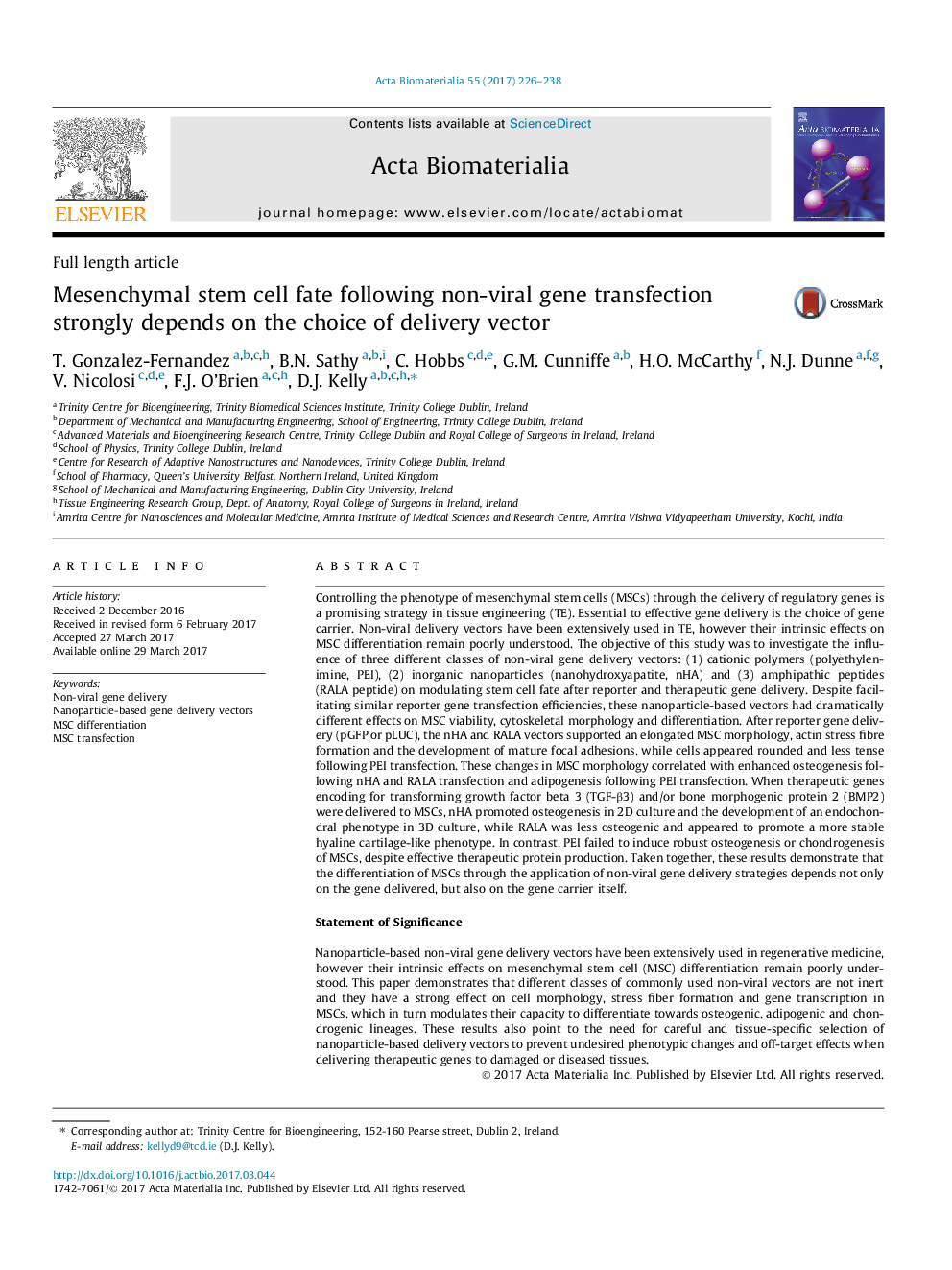| کد مقاله | کد نشریه | سال انتشار | مقاله انگلیسی | نسخه تمام متن |
|---|---|---|---|---|
| 6449232 | 1415931 | 2017 | 13 صفحه PDF | دانلود رایگان |
Controlling the phenotype of mesenchymal stem cells (MSCs) through the delivery of regulatory genes is a promising strategy in tissue engineering (TE). Essential to effective gene delivery is the choice of gene carrier. Non-viral delivery vectors have been extensively used in TE, however their intrinsic effects on MSC differentiation remain poorly understood. The objective of this study was to investigate the influence of three different classes of non-viral gene delivery vectors: (1) cationic polymers (polyethylenimine, PEI), (2) inorganic nanoparticles (nanohydroxyapatite, nHA) and (3) amphipathic peptides (RALA peptide) on modulating stem cell fate after reporter and therapeutic gene delivery. Despite facilitating similar reporter gene transfection efficiencies, these nanoparticle-based vectors had dramatically different effects on MSC viability, cytoskeletal morphology and differentiation. After reporter gene delivery (pGFP or pLUC), the nHA and RALA vectors supported an elongated MSC morphology, actin stress fibre formation and the development of mature focal adhesions, while cells appeared rounded and less tense following PEI transfection. These changes in MSC morphology correlated with enhanced osteogenesis following nHA and RALA transfection and adipogenesis following PEI transfection. When therapeutic genes encoding for transforming growth factor beta 3 (TGF-β3) and/or bone morphogenic protein 2 (BMP2) were delivered to MSCs, nHA promoted osteogenesis in 2D culture and the development of an endochondral phenotype in 3D culture, while RALA was less osteogenic and appeared to promote a more stable hyaline cartilage-like phenotype. In contrast, PEI failed to induce robust osteogenesis or chondrogenesis of MSCs, despite effective therapeutic protein production. Taken together, these results demonstrate that the differentiation of MSCs through the application of non-viral gene delivery strategies depends not only on the gene delivered, but also on the gene carrier itself.Statement of SignificanceNanoparticle-based non-viral gene delivery vectors have been extensively used in regenerative medicine, however their intrinsic effects on mesenchymal stem cell (MSC) differentiation remain poorly understood. This paper demonstrates that different classes of commonly used non-viral vectors are not inert and they have a strong effect on cell morphology, stress fiber formation and gene transcription in MSCs, which in turn modulates their capacity to differentiate towards osteogenic, adipogenic and chondrogenic lineages. These results also point to the need for careful and tissue-specific selection of nanoparticle-based delivery vectors to prevent undesired phenotypic changes and off-target effects when delivering therapeutic genes to damaged or diseased tissues.
MSCs were transfected using either ceramic (nHA) cationic polymer (PEI) or amphipathic peptide (RALA) non-viral gene delivery vectors complexed to plasmid DNA (pDNA) encoding for either reporter or therapeutic genes. After transfection the adipogenic osteogenic and chondrogenic potential of the treated MSCs were assessed in either 2D (monolayer culture in bi-potent media) and 3D (pellet culture) in order to elucidate the effects of the gene transfer nanomaterial on MSC fate.171
Journal: Acta Biomaterialia - Volume 55, June 2017, Pages 226-238
